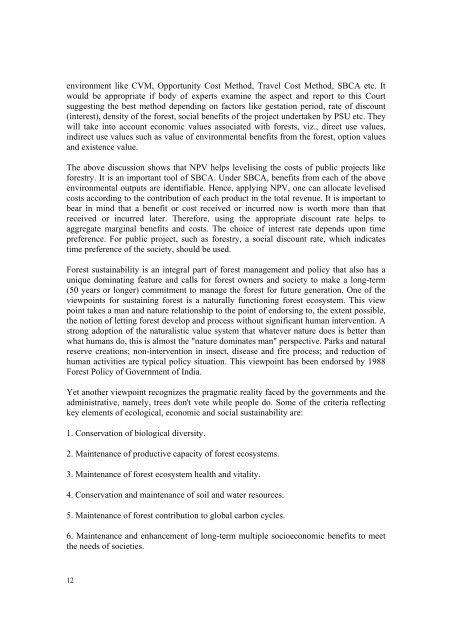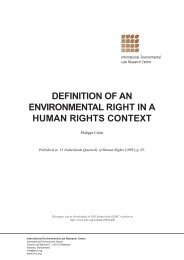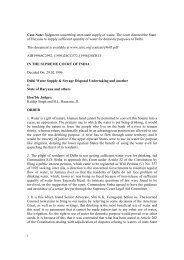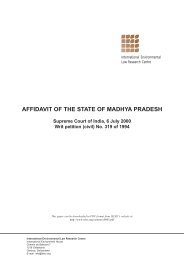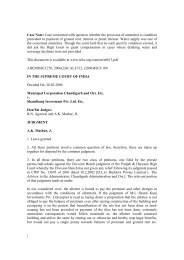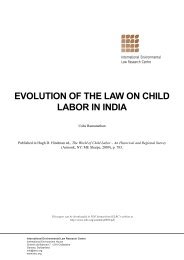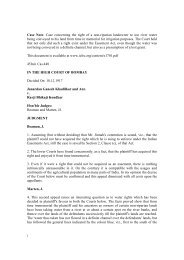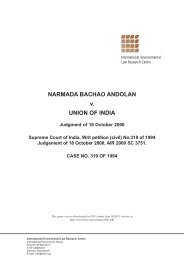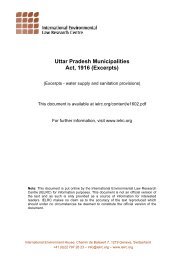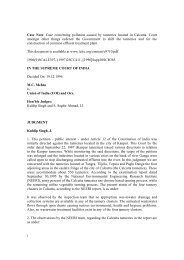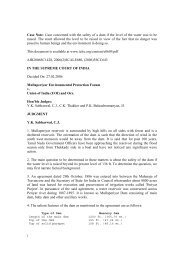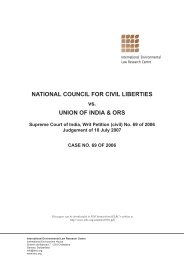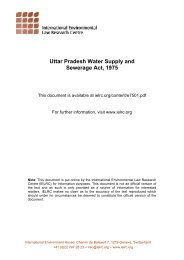T.N. Godavarman Thirumulpad v. Union of India - International ...
T.N. Godavarman Thirumulpad v. Union of India - International ...
T.N. Godavarman Thirumulpad v. Union of India - International ...
Create successful ePaper yourself
Turn your PDF publications into a flip-book with our unique Google optimized e-Paper software.
environment like CVM, Opportunity Cost Method, Travel Cost Method, SBCA etc. Itwould be appropriate if body <strong>of</strong> experts examine the aspect and report to this Courtsuggesting the best method depending on factors like gestation period, rate <strong>of</strong> discount(interest), density <strong>of</strong> the forest, social benefits <strong>of</strong> the project undertaken by PSU etc. Theywill take into account economic values associated with forests, viz., direct use values,indirect use values such as value <strong>of</strong> environmental benefits from the forest, option valuesand existence value.The above discussion shows that NPV helps levelising the costs <strong>of</strong> public projects likeforestry. It is an important tool <strong>of</strong> SBCA. Under SBCA, benefits from each <strong>of</strong> the aboveenvironmental outputs are identifiable. Hence, applying NPV, one can allocate levelisedcosts according to the contribution <strong>of</strong> each product in the total revenue. It is important tobear in mind that a benefit or cost received or incurred now is worth more than thatreceived or incurred later. Therefore, using the appropriate discount rate helps toaggregate marginal benefits and costs. The choice <strong>of</strong> interest rate depends upon timepreference. For public project, such as forestry, a social discount rate, which indicatestime preference <strong>of</strong> the society, should be used.Forest sustainability is an integral part <strong>of</strong> forest management and policy that also has aunique dominating feature and calls for forest owners and society to make a long-term(50 years or longer) commitment to manage the forest for future generation. One <strong>of</strong> theviewpoints for sustaining forest is a naturally functioning forest ecosystem. This viewpoint takes a man and nature relationship to the point <strong>of</strong> endorsing to, the extent possible,the notion <strong>of</strong> letting forest develop and process without significant human intervention. Astrong adoption <strong>of</strong> the naturalistic value system that whatever nature does is better thanwhat humans do, this is almost the "nature dominates man" perspective. Parks and naturalreserve creations; non-intervention in insect, disease and fire process; and reduction <strong>of</strong>human activities are typical policy situation. This viewpoint has been endorsed by 1988Forest Policy <strong>of</strong> Government <strong>of</strong> <strong>India</strong>.Yet another viewpoint recognizes the pragmatic reality faced by the governments and theadministrative, namely, trees don't vote while people do. Some <strong>of</strong> the criteria reflectingkey elements <strong>of</strong> ecological, economic and social sustainability are:1. Conservation <strong>of</strong> biological diversity.2. Maintenance <strong>of</strong> productive capacity <strong>of</strong> forest ecosystems.3. Maintenance <strong>of</strong> forest ecosystem health and vitality.4. Conservation and maintenance <strong>of</strong> soil and water resources.5. Maintenance <strong>of</strong> forest contribution to global carbon cycles.6. Maintenance and enhancement <strong>of</strong> long-term multiple socioeconomic benefits to meetthe needs <strong>of</strong> societies.12


